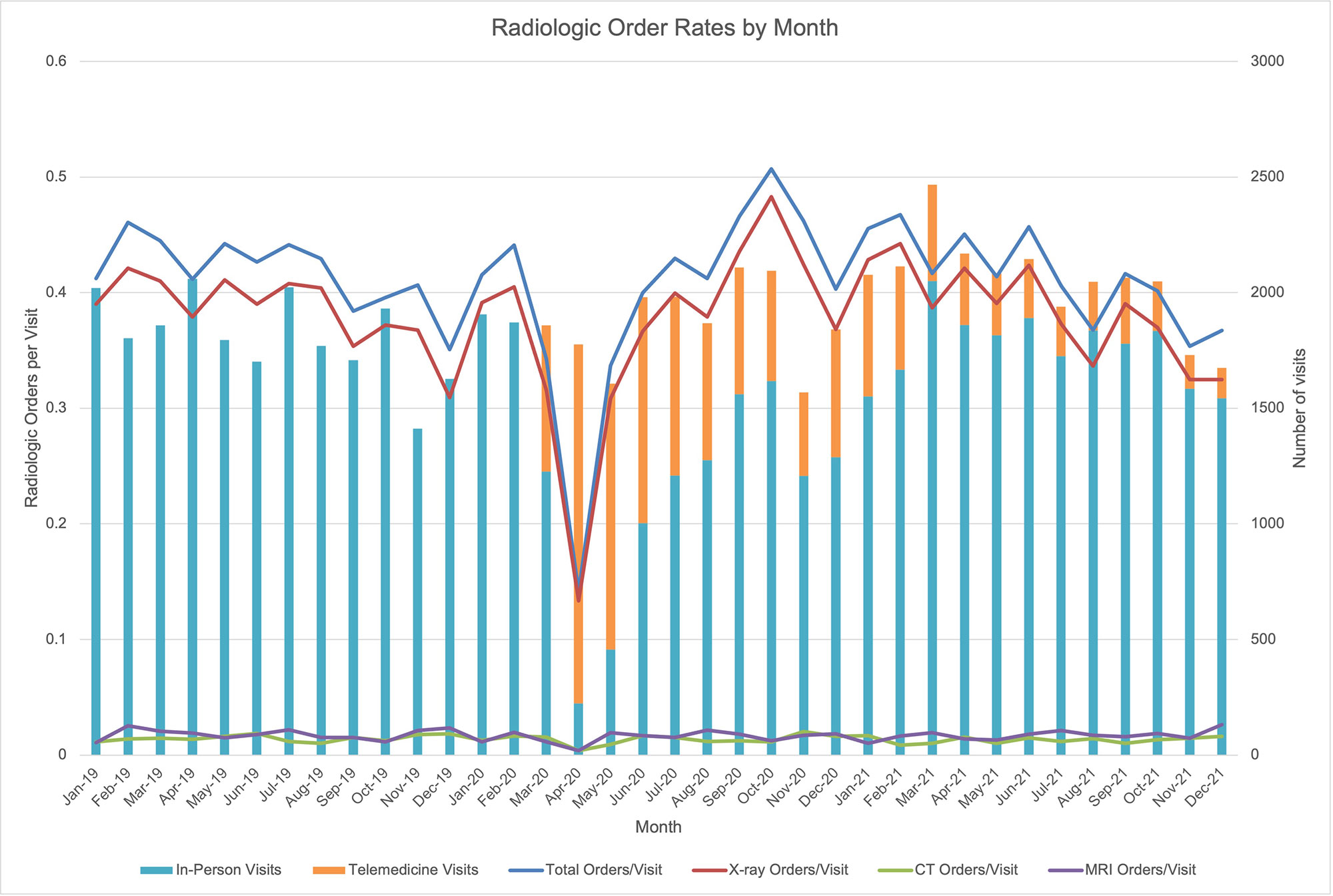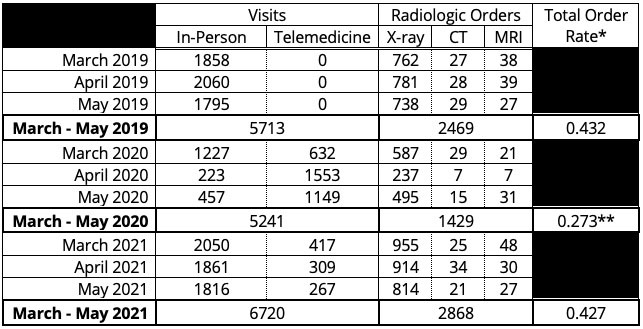Session Information
Session Type: Poster Session C
Session Time: 1:00PM-3:00PM
Background/Purpose: The COVID-19 pandemic necessitated the rapid implementation of telemedicine, and this shift’s impact on practice patterns is still being characterized. We theorized that telemedicine – by limiting physical exam data – might affect the rate at which rheumatologists order imaging studies. To explore this theory, we analyzed rheumatology providers’ rates of ordering radiologic studies before, during, and after a COVID-19-related shift to telemedicine.
Methods: We analyzed the number of monthly in-person visits, telemedicine visits, and radiologic orders (separated into CT, MRI, and X-ray) in a single academic rheumatology practice from January 2019 to December 2021. Data were collected using Epic’s SlicerDicer program. From this data, we calculated a monthly ‘ordering rate’ – as the total number of radiologic orders (CT, MRI, and X-ray) divided by the total number of visits (in-person and telemedicine), per month. We compared ordering rates from March through May 2020 to the same time period in 2019 (baseline) to understand how ordering rates changed with a rapid shift to telemedicine at the beginning of the COVID-19 pandemic. In addition, we compared ordering rates from March through May 2021 to the 2019 baseline to understand if there was any lasting impact on imaging ordering. Rates were compared using ANOVA and Fisher’s least significant difference.
Results: There were no telemedicine visits in the practice prior to March 2020. There was a rapid shift to telemedicine in March through May 2020, after which telemedicine declined to approximately 10% of visits by the end of 2021 (Figure 1). There was a rapid decline in total imaging orders with the onset of COVID-19 in March through May 2020, followed by a slight increase in October 2020, after which time imaging orders appeared to return to the prior baseline. When ordering rates for March through May of 2019, 2020, and 2021 were compared, we found a decrease in total ordering rate during telemedicine’s 2020 implementation (0.273 orders/visit), and found no difference in ordering rate between 2019 (0.432 orders/visit) and 2021 (0.427 orders/visit) (Table 1).
Conclusion: In this academic rheumatology practice, the COVID-19 pandemic caused a rapid adoption of telemedicine in March 2020 that persisted through December 2021. During this transition, total radiologic ordering rate initially decreased, before recovering to similar pre-telemedicine rates. Therefore, the shift to telemedicine had a brief – but temporary – impact on the rheumatology practices’ ordering rate. Although rheumatology practice has changed dramatically in many ways in the wake of COVID-19, it does not appear that the pandemic or the resultant adoption of telemedicine has led to any major shift in radiologic utilization.
* calculated as total radiologic orders divided by total visits.
** indicates statistical significance (p<0.05), when compared with 2019 and 2021 order rates by ANOVA and Fisher’s least significant difference.
To cite this abstract in AMA style:
Kellogg B, French R, Vinson E, McCrum E, leverenz d. Telemedicine’s Impact on Radiologic Ordering in an Academic Rheumatology Practice During the COVID-19 Pandemic [abstract]. Arthritis Rheumatol. 2022; 74 (suppl 9). https://acrabstracts.org/abstract/telemedicines-impact-on-radiologic-ordering-in-an-academic-rheumatology-practice-during-the-covid-19-pandemic/. Accessed .« Back to ACR Convergence 2022
ACR Meeting Abstracts - https://acrabstracts.org/abstract/telemedicines-impact-on-radiologic-ordering-in-an-academic-rheumatology-practice-during-the-covid-19-pandemic/


